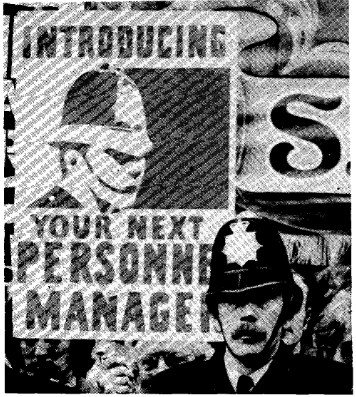This essay is reproduced here as it appeared in the print edition of the original Science for the People magazine. These web-formatted archives are preserved complete with typographical errors and available for reference and educational and activist use. Scanned PDFs of the back issues can be browsed by headline at the website for the 2014 SftP conference held at UMass-Amherst. For more information or to support the project, email sftp.publishing@gmail.com
Notes from England: The New McCarthyism and the Rise of the National Front
by Hilary & Steven Rose
‘Science for the People’ Vol. 10, No. 4, July/August 1978, p. 4
The last six months have seen a considerable heightening of political struggle in Britain—a struggle which deeply involves issues of concern to the radical science movement. Two areas in particular may be of special interest to SftP.
The Attack on Education
The first has been a mounting attack from theRight on the development and space available for critical, radical and Marxist thought in education. This was exemplified last September by the publication of a report entitled The Attack on Higher Education: Marxist and Radical Penetration, edited by an hitherto obscure sociology professor at Nottingham University, Julius Gould, and published by a London-based, counterinsurgency-funded organisation, The Institute for the Study of Conflict (ISC). (An earlier ISC report dealt with trade union militants; a future one promises to discuss the communication industry.) The governing Council of the ISC includes British intelligence experts, and its financial backers number amongst them the publicity body for big British capital, Aims of Industry, and reputedly, the CIA.
The report claimed that British universities and polytechnics had been infiltrated by a network of Marxists and other radicals who had subverted teaching courses, and presumably the minds of students, by substituting ‘radical’ for ‘liberal’ scholarship. The report named a number of institutions and listed individuals and organizations that were ‘characteristic’ of the radical mode of thinking—representing, Gould claimed, in words reminiscent of the late U.S. Senator Joseph McCarthy, “a clear and present danger”. In fact Gould’s analysis was very crude, as it lumps together old and new Left and liberals as part of the destabilizing enemy. Even philosopher of science Thomas Kuhn comes in for criticism as contributing to the attack on liberal objectivity. Gould’s report was widely circulated to heads of universities, central and local government administrators, etc. It was also given wide press coverage, particularly by The Times newspapers and the right-wing Telegraph. The latter claimed to identify additional evidence of ‘Marxist bias’ in the teaching of several institutions, particularly the Open University, a part-time open entry college for adults which, with over 60,000 students, is now Britain’s largest university.

The main text of the Gould report is devoted to attacking the critical thought which has developed in several areas of cultural struggle over the last decade: philosophy, education, sociology, social work, and science (but not the women’s movement). Whilst the issues posed by Gould for social work are of considerable importance, here we will only discuss the consequences in science and education, where SftP’s parallel organisation in Britain, BSSRS, (British Society for Social Responsibility in Science)* [FOOTNOTE: BSSRS, 9 Poland St., London WI: The Society was set up in 1968 and consists of socialists concerned with issues surrounding science and technology in capitalist society. They publish the quarterly magazine Science for People.] comes in for special criticism, as do two books which we ourselves have recently edited, The Political Economy of Science and The Radicalisation of Science (Macmillan, 1976). What Gould takes exception to is the theoretical attack which the radical science movement has mounted on certain sacrosanct ideas of bourgeois science—namely its neutrality, objectivity, reductionism—and the possibility that bourgeois science may be opposed by socialist science. In addition—a point also seized upon by the Telegraph—he is outraged by the fact that the royalties from the books go to Vietnam, for reconstruction of science by way of the Institute for Science and Technology, Ho Chi Minh City.
The response by the Left, both individually and collectively, and by the unions to the Gould report was strong. The drift to McCarthyism, with its threat to freedom for critical thought, has been condemned by the 26,000 strong (British) Association of University Teachers and the 360,000 strong Association of Scientific, Technical and Managerial Staff, and in resolutions by some University Senates. Many universities and polytechnics have had special meetings to mobilize resistance to the effects of the report, and the national Council for Academic Freedom and Democracy has published a counter-pamphlet.
However, there is no doubt that Gould’s words have had a sympathetic hearing from some university administrators and Tory (conservative) politicians. They must be judged in light, too, of the persistence in West Germany of the law which prevents Marxists or other radicals from taking up any post at all in universities or schools (not merely as teachers, but also as secretaries or technicians). This law—the so-called Berufsverbot—is directed against civil servants of all kinds; several million people have been screened, and several hundred have already lost their jobs under this law (grounds for dismissal have included being seen in a left-wing bookshop or having parked one’s car near a demonstration!).
Despite the generally powerful response from the Left and liberals to the new McCarthyism, BSSRS itself was less able to respond as a group because of the internal divisions which have tended to fragment it over the past year or so. These have involved political disagreements about the nature of the class analysis of science, theoretical divisions over the nature of science itself, and personal differences between individuals based on these differences in theory and practice. These divisions have made BSSRS less able to react either to Gould or to the second and more important threat from the Right which has, over the past few months, shifted the entire British political spectrum sharply to the right. This is the growing power of England’s neo-Nazi party, the National Front.
 One can find the ideological roots of the National Front in the programme of the “Greater Britain movement”, founded in 1964 by John Tyndall, now Chairman of the NF: “For the protection of British blood, racial Ia ws will be enacted forbidding marriage between Britons and non-Aryans. Medical measures will be taken to prevent procreation on the part of all those who have hereditary defects, either racial, mental, or physical. A pure, strong, healthy British race will be regarded as the principal guarantee of Britain’s future.”
|
Racists and the National Front
The National Front (NF) is a more-or-less unified party which has developed in the last few years out of a heterogeneous grouping of neo-Nazis, Empire loyalists, right-wing conservatives and racists. It has fed on the crisis of capital in Britain, with its chronic unemployment, inflation and decaying inner cities, the derelict nationalism of a dead empire, and a deep seated racist response to the growth of the ethnic minorities (which grew in Britain, as elsewhere in Western Europe in the boom years of the late 1950s and early 1960s). The role of the Labour Party in Britain—managing the economic crisis in the interest of capital and so betraying the labour movement it supposedly represents—has certainly helped this growth, which had reached the point in the spring of this year where NF candidates could poll up to 6% in national elections and much higher in local elections.
Racist thinking is deeply embedded in the ideology of the NF, which is anti-black and anti-semitic. Much of its ideology comes straight from the Nazi theoreticians of the 1930s, but it has eagerly seized upon the new ‘scientific racism’ of Jensen, Eysenck and Shockley, all of whom are cited in its publications. Its national organiser, Martin Webster, (who once boasted of creating a ‘well-oiled Nazi machine’ in Britain), wrote:
The most important factor in the build up of self confidence amongst “racists” and the collapse of morale among multi-racialists was the publication in 1969 by Professor Arthur Jensen in the Harvard Educational Review.
Within months of Gould’s attack on radicals in higher education, the NF launched a major recruiting drive for schoolchildren, with the mass distribution of a leaflet entitled “How to Spot a Red Teacher”. Along with a drawing of an identifiably Jewish face for the teacher concerned, kids are told:
—- “The Racial Equality Lie”
—-“Commie teachers will tell you that all races are ‘equal’. They will tell you that intelligence is not inborn, but is produced by a ‘good environment’. They will tell you that if all races were brought up in the same environment they would all be equal.”
—”Tell the Red teacher that top scientists like Jensen and Eysenck say this is rubbish. Scientists say that races are born different in all sorts of ways, especially in intelligence.”
— “This is because we inherit our abilities genetically”.
And so on.
Anyone who thought that the battle against scientific racism was merely a campus struggle between intellectuals should now think again. Scientific racism of this sort is a crucial element in National Front thinking and campaigning in Britain. Recently, U.S. newspapers too have carried pictures of the street battles in the major cities in England where the NF has tried to march and been stopped by working people, community and ethnic groups, and the Left organisations. Several unions are now considering expelling NF members, and there is a growing union of school students, the NUSS, which is organizing against the NF—often in cooperation with the local teachers—in the schools. And above all, there is the growing development and the local and national levels of campaigns against racism and fascism and of the Anti-Nazi League. This campaign resulted in a mjor electoral setback for the NF, whose vote at the local elections this spring slumped to a derisory 2-3% The result has been that the NF, thwarted temporarily at the ·polls, has shifted its tactics even more towards street violence. While individual activists in the radical science movement have been involved in the campaign against the Front, the fragmentation of the radical science movement as a whole and of BSSRS must be overcome if all possible forces against scientific racism in particular, and racism and fascism in general, are to be mobilized.

>> Back to Vol. 10, No. 4 <<
Hilary and Steven Rose have been active in the radical science movement since its birth in the late 1960s, especially over the issues of chemical and biological warfare and weapons of social control. Steven is a professor of biology at the Open University, and Hilary is a professor of applied social studies at the University of Bradford.

